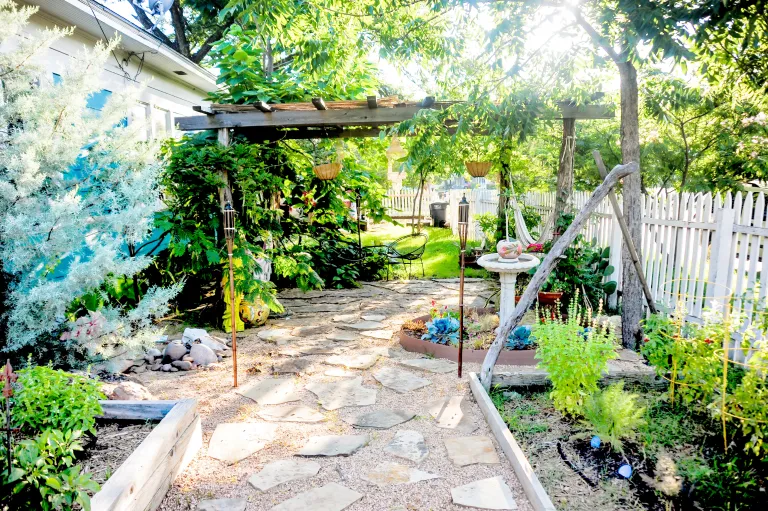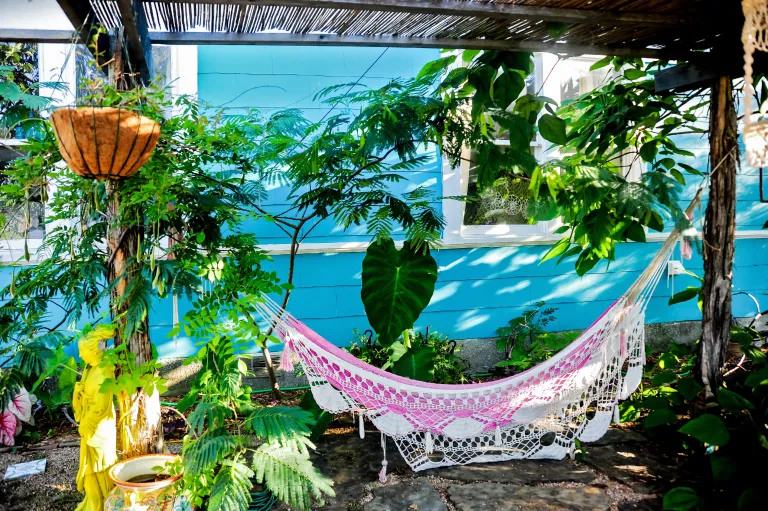2100 Washington Ave – Yard of the Month (July 2017)
July 1, 2017
News
July’s winner for Yard of the Month is 2100 Washington Ave. The home was built in 1920 by H. F. Fulpe, formerly of Tulsa, OK, for $1300; it is a single-story, 1200+ square foot Craftsman-style bungalow on a generous corner lot at Hawthorne and Washington. In 1935, Fulpe applied for a permit to add a garage and ready the home for sale with repairs and upgrades. Later that year, John and Aurelia Shell of 2200 Alston bought 2100 Washington as a rental/investment property for $1700. The Shells leased the Washington Ave. bungalow to John’s coworker from the Cattle Commission, Lola Hettie Dobkins (Lola was in the clerical pool, and John, livestock sales). For many years, Lola shared the bungalow with her mom Bessie; big sister Opal, a secretary in pharmaceutical and blood serum sales; younger sister Bessie Conower, and niece Dorothy Conower. In 1982, the home was purchased by Ira Eugene Edwards of Denton; 17 years later, he sold it to an airman and his wife returning to Texas after a stint at Mather and McClellan Air Force Bases in Northern California. In the early 2000s, we find the bungalow’s most heartbreaking chapter, for the owners were convicted of “cult-inspired, ritualistic child abuse,” following a trial in Sacramento with the ‘prophet’ of their polygamous sect. The home was then purchased at auction by Clayton Holmes, who flipped multiple houses in Fairmount in the late 1990s and early 2000s. Holmes cut down a magnolia tree disrupting the porch foundation and highlighted the home’s Craftsman features with distinctive curved porch braces and a windowed, 3-light front door. He painted 2100 a sunny buttercream with brick red accents and white trim
Today, 2100 Washington has escaped its tragic past, and is on a definite trajectory of improvement under the care of its current owners. Their interests in visual culture, music and travel are reflected throughout the garden and interior of the home. The bungalow, decorated in bohemian chic style, is filled with collections of painting, glass, china and musical instruments. The airy, open interior is soothed by a palette of whites, salmons, ice blue and pinks. The exterior paint is peacock-blue with a citron-colored front door and white columns; the porch is filled with potted succulents, Mexican folk art, and midcentury patio seating collected during their summer travels throughout the southwest. 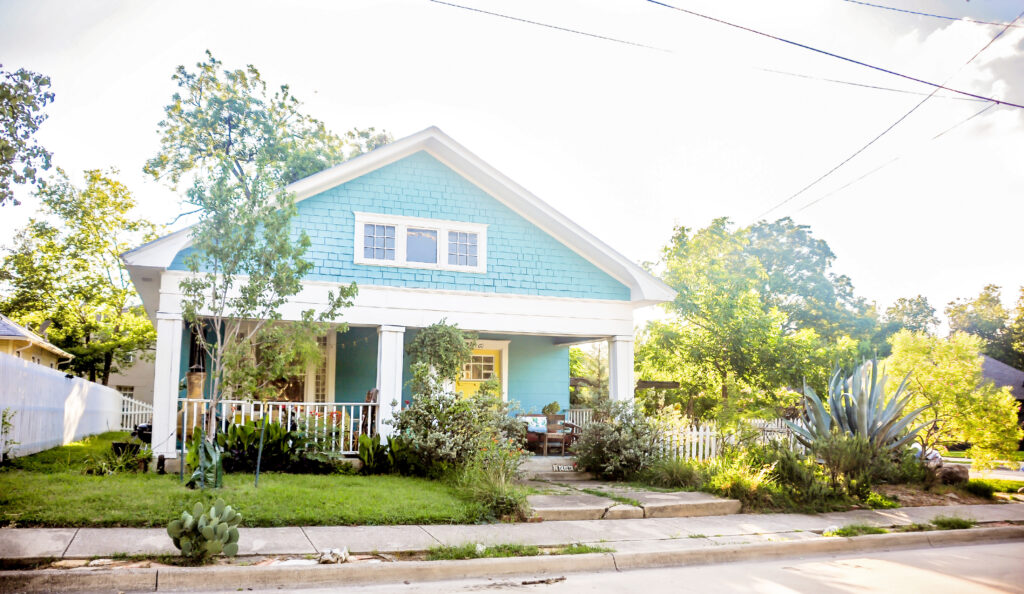
One of the first things the current owners did after purchasing the house in 2007 was to hire the landscaping crew of Elizabeth Anna’s Old World Garden on 8th Avenue to remove cyclone fencing and grind down the stumps of multiple “trash trees,” especially hackberries, entwined in the chain link. Once they’d achieved a blank slate, Elizabeth provided landscape design advice to the new homeowners. They framed the front and side yards of 2100 Washington with tall gothic-style picket fencing, painted white. While wood fencing requires significantly more maintenance than the metal grid, it is less hospitable to invasive trees and complements the look of a clapboard house. In the sideyard, they built a wooden pergola for shade and entertaining and installed several raised vegetable beds with tomatoes, basil, and sunflowers. The pergola supports two wisterias and a crossvine (Bignonia capreolata). Under its shade, we find ceramic pots, two hammocks, a circular bed of ornamental cabbages, and a statue of a Japanese geisha in vibrant saffron.
The couple find their garden inspiration in the landscaping of the Texas Hill country, where gravel walks frame xeriscaped beds of rosemary, cacti, zexmenia, mountain laurel and soft Muhly grasses. The plantings on three sides of the home are not only water-wise, but also show skillful juxtaposition of texture and scale. Their favorite shop for purchasing plants is The Great Outdoors, a nursery on S. Congress in Austin, TX. One of their first plants was purchased there: a blue agave (agave tequiliana), which they call the “baby,” more as a joke on their solicitous, decade-long care of the plant, than its massive scale. In winter, the agave wears burlap sheets and Christmas lights to prevent freezes (and also because it looks cool). Despite some dings from the great St. Patrick’s Day hailstorm of 2016, the mammoth agave remains an impressive anchor in the lot’s right quadrant, at well over 7 feet high and about 10 feet in diameter. They anticipate, but also dread, the agave’s flowering and pollination, because after once blooming, agave plants die. Nearby, South African native bulbines (bulbine fruitescens) sport pretty yellow and orange flowers at the top of broom-like stalks. Their colors are amplified by two types of Bird of Paradise trees, the red-blooming peacock flower (Caesalpinia pulcherrima) and the yellow Barba de Chivo or “goat’s beard” (Caesalpinia gilliesii) flanking the porch. Texas sage bushes frame the front walkway, bursting in mauve blossoms after recent heavy rains. An orange and yellow milkweed (aesclepias) provides a nectar source for butterflies and bees; irises from the garden of the owner’s late mother have recently finished blooming. Two five-foot spineless prickly pear cacti (opuntia stricta) bordering both sides of the picket fence produce lemony flowers followed by mulberry-colored fruits.
home are not only water-wise, but also show skillful juxtaposition of texture and scale. Their favorite shop for purchasing plants is The Great Outdoors, a nursery on S. Congress in Austin, TX. One of their first plants was purchased there: a blue agave (agave tequiliana), which they call the “baby,” more as a joke on their solicitous, decade-long care of the plant, than its massive scale. In winter, the agave wears burlap sheets and Christmas lights to prevent freezes (and also because it looks cool). Despite some dings from the great St. Patrick’s Day hailstorm of 2016, the mammoth agave remains an impressive anchor in the lot’s right quadrant, at well over 7 feet high and about 10 feet in diameter. They anticipate, but also dread, the agave’s flowering and pollination, because after once blooming, agave plants die. Nearby, South African native bulbines (bulbine fruitescens) sport pretty yellow and orange flowers at the top of broom-like stalks. Their colors are amplified by two types of Bird of Paradise trees, the red-blooming peacock flower (Caesalpinia pulcherrima) and the yellow Barba de Chivo or “goat’s beard” (Caesalpinia gilliesii) flanking the porch. Texas sage bushes frame the front walkway, bursting in mauve blossoms after recent heavy rains. An orange and yellow milkweed (aesclepias) provides a nectar source for butterflies and bees; irises from the garden of the owner’s late mother have recently finished blooming. Two five-foot spineless prickly pear cacti (opuntia stricta) bordering both sides of the picket fence produce lemony flowers followed by mulberry-colored fruits.
The Hawthorne Street parkway features a line of drought-tolerant trees, blooming in succession throughout spring and summer. Currently in flower is the Rio Salado desert willow (chilopsis linearis); March saw two Texas redbuds covered in orchid-colored clusters, followed in May by the blue-violet blooms of a Vitex. Among the most beautiful of their flowering trees in mid-summer is the Albizia julibrissin, commonly known as flame mimosa, named for 18th-century Italian botanist, Filippo degli Albizzi. Interesting features of the albizia include bipinnate (aka, fern-like) leaves, and feathery, salmon pink summer blooms. Julibrissin is a Latinization of gul-i abrisham, meaning “silk flower” in Persian, but in China it is known as the “tree of happiness” for its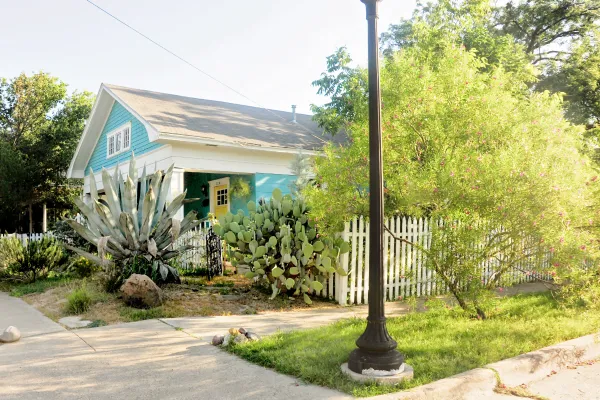 herbal properties, which purportedly include lessening depression and insomnia. The albizia’s characteristically frilly blooms are actually stamen, rather than flower petals, which makes the plant very attractive to hummingbirds. In rainy, tropical climates, albizias can become invasive, their rapid growth posing a danger to power lines. Our dry summers keep them in check, though, and albizia add dramatic beauty to the landscape while attracting pollinators.
herbal properties, which purportedly include lessening depression and insomnia. The albizia’s characteristically frilly blooms are actually stamen, rather than flower petals, which makes the plant very attractive to hummingbirds. In rainy, tropical climates, albizias can become invasive, their rapid growth posing a danger to power lines. Our dry summers keep them in check, though, and albizia add dramatic beauty to the landscape while attracting pollinators.
Closer to the house, a vast catalpa (or catawba) displays multiple trunks, heart-shaped leaves, showy white flowers, and long, narrow seed pods which led to its other alias, the cigar tree. Luthiers sometimes use catalpa as tonewood in guitars, and the tree is also a food source for sphinx moth caterpillars. Under its shade, caladiums in white, pink, and red cluster around hostas, oxalis, and elephant ears, flanking the living and dining room windows: this bed ends in a white crape myrtle tree planted by a prior owner. In the backyard, dominated by a magnificent 100-year-old pecan tree, the couple enclosed a berm in railroad ties, a handy framing device, but one which he cautions is not for culinary beds, due to the creosote tar used to preserve the wood. Behind this bed, there is a new addition to the landscape: sitting in the gravel driveway is a buff-colored Blue Bird school bus the couple are converting to a tiny home/RV. Having removed the seats and installed a plywood subfloor, the couple will install a galley kitchen, seating and sleeping amenities, and a shower. They anticipate using it for their summer excursions, as well as for visiting relatives: from its high windows, lucky guests will have a beautiful view of one of Fairmount’s most unique and artistic gardens.
Photo of the blue agave when they first planted it until now shared by homeowner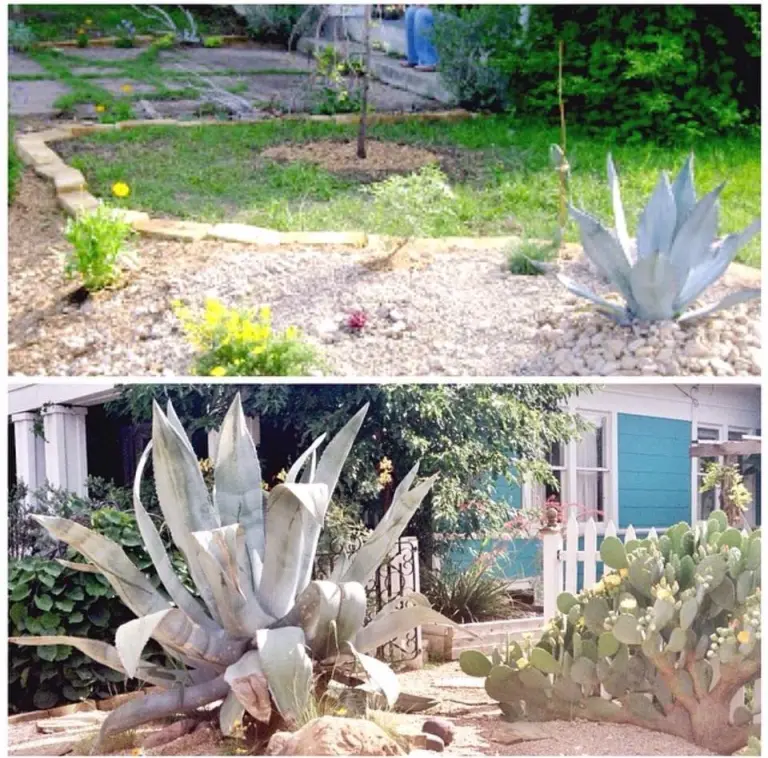
Our thanks, and a $30 gift certificate to Ephemera, go to the winners.
The Yard of the Month committee is Susan Taylor Harper and Bonnie Blackwell.
- Share

